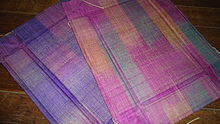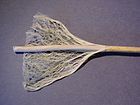- Abacá
-
Abacas redirects here, for the mathematical implement, see abacus
Abacá
Musa textilis
Scientific classification Kingdom: Plantae (unranked): Angiosperms (unranked): Monocots (unranked): Commelinids Order: Zingiberales Family: Musaceae Genus: Musa Species: M. textilis Binomial name Musa textilis
Née Mats made from woven Abacá fibers from the Philippines.
Mats made from woven Abacá fibers from the Philippines.
Abacá, Musa textilis (English pronunciation: /ɑːbəˈkɑː/ ah-bə-KAH, from Spanish "abacá" for Musa textilis) is a species of banana native to the Philippines, grown as a commercial crop in the Philippines, Ecuador, and Costa Rica. The plant is of great economic importance, being harvested for its fibre, once generally called Manila hemp, extracted from the trunk or pseudostem. On average, the plant grows about 12 feet (4 meters) tall. The fiber was originally used for making twines and ropes; now most abacá is pulped and used in a variety of specialized paper products including tea bags, filter paper and banknotes. It is classified as a hard fiber, along with coir, henequin and sisal.
Abacá was first cultivated on a large scale in Sumatra in 1925 under the Dutch, who had observed its cultivation in the Philippines for cordage since the 19th century, followed up by plantings in Central America in 1929 sponsored by the U.S. Department of Agriculture.[1] Commercial planting began in 1930 in British North Borneo; with the commencement of WWII, the supply from the Philippines was eliminated by the Japanese.[1] Today, abaca is produced commercially in only three countries: Philippines, Ecuador, and Costa Rica. Yields are highest in Costa Rica, but the industry is new and planted acreage limited.
Contents
Composition
The leaves grow from the trunk of the plant, the bases of the leaves form a sheath (covering) around the trunk; there are approximately 25 of these, with 5 cm in diameter and from 12 to 25 leaves with overlapping petioles, covering the stalk to form a shrub, "false trunk" or pseudostem about 30 to 40 cm in diameter.[1] They grow in succession, with the oldest growing from the bottom of the trunk and successively younger ones from the top. The sheaths contain the valuable fibre. The coarse fibres range from 5 to 11½ feet (1.5 to 3.5 metres) in length. They are composed primarily of cellulose, lignin, and pectin.
Applications
Most abacá fiber is pulped and processed into specialty paper used in tea bags, vacuum bags, currency, and more.[citation needed] It can be used to make handcrafts like bags, carpets, clothing and furniture. Abacá rope is very durable, flexible and resistant to salt water damage, allowing its use in hawsers, ship's lines and fishing nets.[1] Abacá fiber was once used primarily for rope, but this application is now of minor significance. Lupis is the finest quality of abacá. Sinamay is woven chiefly from abacá.[2]
Harvesting
The plant is normally grown in well-drained loamy soil, using pieces of mature root planted at the start of the rainy season.[1] Growers harvest abacá fields every three to eight months after an initial growth period of 12–25 months and a total lifespan of about 10 years.[1] Harvest generally includes having several operations concerning the leaf sheaths:
- tuxying (separation of primary and secondary sheath)
- stripping (getting the fibres)
- drying (usually following tradition of sun-drying).
In Costa Rica, more modern harvest and drying techniques are being developed to accommodate the very high yields obtained there.
The fibers can then be spun into twines or cordage, or used in the pulping process for fine paper.
Scientific classification
The abacá plant belongs to the banana family, Musaceae; it resembles the closely related wild seeded bananas, Musa acuminata and Musa balbisiana. Its scientific name is Musa textilis.
See Also
References
- The World Book encyclopedia set, 1988.
- See International Year of Natural Fibres 2009
- Christenhusz, M.J.M. (2009). Typification of ornamental plants: Musa textilis (Musaceae). Phytotaxa 2: 53-54.
External links
- Historical notes
- Plants USDA
- abacá A comprehensive pamphlet about Philippine abacá presented 1915 Panama Pacific International Exposition held in San Francisco. Online publication uploaded in Filipiniana.net
Fibers Natural Mineral
Synthetic CelluloseMineralCategories:- Musaceae
- Flora of the Philippines
- Tagalog words and phrases
- Fiber plants
- Biodegradable materials
Wikimedia Foundation. 2010.
